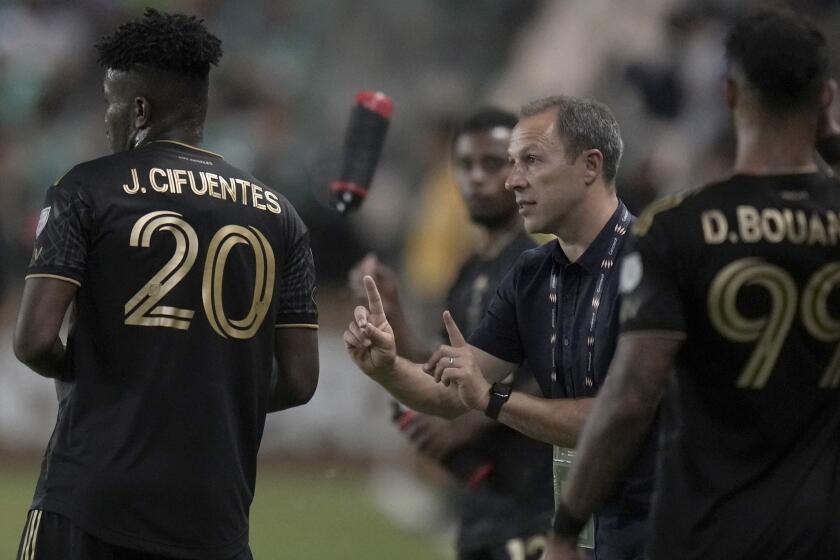IT’S TIME TO SIGN ON THE DOTTED LINE : It’s the Moment of Truth : Letter of Intent Day Weighs on Recruits
- Share via
It’s a harmless-looking document--just a page long with only five blanks to fill.
The most difficult task it demands is a knowledge of one’s social security number.
But for a high school athlete, whose biggest previous decision may have been whether to play defensive back or running back, signing a national letter of intent is a weighty event. The letter symbolizes the moment of truth for an athlete’s collegiate future.
Confronted with the letter of intent, some react unpredictably.
Kevin Willhite, one of California’s best high school running backs in the class of 1982, publicly indicated he planned to attend the University of Washington. That was understandable since the Huskies had been to two consecutive Rose Bowls.
But, the standout from Rancho Cordova High School near Sacramento, also was the state 200-meter champion, and Washington was not renowned for its track and field program. Nonetheless, on the first day of the signing period, the Huskies’ football recruiter appeared at the Willhite residence, with letter in hand and every reason to be confident.
A recruiter from Oregon also showed up. For him, it was an outside chance. Although the Ducks were the Pac-10’s second-best track team, they were second-from-the-bottom in football.
But things began deviating from Washington’s script when the recruit excused himself, leaving both recruiters sitting in his living room while he locked himself in the bathroom.
According to John Lashway, Oregon’s assistant sports information director, Willhite stared at himself in the mirror for a time. Then he emerged and announced, “It’s Oregon.” He signed the Ducks’ letter, leaving the Husky coach to depart empty-handed.
The practice of a high school athlete signing an agreement to attend a specific college was pioneered in 1964 by 25 four-year colleges, including schools in the Southwestern and Big Eight conferences. Their hope was to save recruiting money and time, while sparing students the bother of fending off recruiters until the day they checked into dormitories.
Today, 32 conferences and 86 independent colleges use the letter of intent, which is supervised by the conferences’ Collegiate Commissioners Assn. That includes nearly all four-year colleges.
The notable exceptions are the service academies, which do not accept students’ congressional nominations in time to participate in the signing program, and the Ivy League, which distributes its financial aid based on academic rather than athletic performance.
The letter of intent represents the first major legal obligation most of the students have accepted. It’s something like joining the Army; once you sign those papers, there’s rarely any turning back.
Under most circumstances, the signed letter of intent binds an athlete to a college for at least one year. The penalty for switching schools is two years of lost eligibility, unless the original school signs a release. In that case, one year of eligibility is sacrificed.
Very few players manage to scramble out of a signed letter the way Ram quarterback Vince Ferragamo did when he was at Banning. Today, football letters are delivered in person by a college assistant coach. But when Ferragamo was a hotly recruited in 1972, the blank letters came in the mail.
Ferragamo signed a letter of intent from Stanford and dropped it in the mail. Later the same day he changed his mind. Ferragamo’s solution was to make an interception, probably the most important of his football career.
He and his brother Chris Ferragamo, who coaches at Banning, wound up begging the Wilmington postmaster for permission to retrieve the letter. That was against postal regulations, but the postman did allow Ferragamo to open the letter and scratch out his signature before returning it to the mail. Ferragamo subsequently signed a letter to attend Cal.
Normally, there are only a handful of ways a signed letter of intent can be nullified:
- If the athlete fails to meet the admission standards of the school to which he signed a letter, including the NCAA’s 2.0 high school grade-point average requirement.
- If an athlete attends and graduates from a junior college.
- If an athlete doesn’t go to any college for a year and later is denied an athletic scholarship to the college to which he signed his letter.
- If the athlete opts for 18 months of active duty in the armed forces or 18 months as a religious missionary.
- If the sport is dropped at the college to which an athlete signed a letter.
More to Read
Go beyond the scoreboard
Get the latest on L.A.'s teams in the daily Sports Report newsletter.
You may occasionally receive promotional content from the Los Angeles Times.










